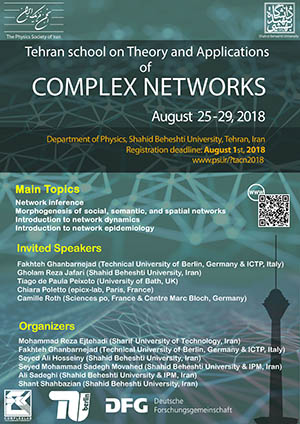Tehran school on Theory and Applications of Complex Networks
25-29 August 2018 (3-7 Shahrivar 1397),
Department of Physics, Shahid Beheshti University (SBU), Tehran, IRAN
Fakhteh Ghanbarnejad (Berlin)
Title: Introduction to network science: structure and dynamicsAbstract: Networks are the natural way to describe the skeleton of complex systems. The structure of interactions among the constituents of complex networks plays a key role in its functioning, in particular for the unfolding of collective behaviors. In these lectures we will introduce some of the most relevant structural and dynamical frameworks that lead to collective behaviors whose onset is largely influenced by the interaction patterns. We will review structural features as well as simple dynamical processes highlighting their connection with the underlying network topology like: Diffusion, Random Walks, Stochastic contagion dynamics.
Files:
fakhteh1.pdf
fakhteh2.pdf
Tiago de Paula Peixoto (University of Bath, UK)
Title: Network inferenceAbstract: Network structures are shaped by evolutionary mechanisms and determine the central aspects of how a system functions. However, differently from systems that are naturally embedded in space, we cannot simply "look" at network in order to extract its most important structural patterns. Instead, we must rely on well-founded algorithmic methods to extract this information from data in an interpretable way. In this lecture, we review a principled approach to this problem based on the elaboration of probabilistic models of network structure, and their statistical inference from empirical data.
We aim to cover the following topics:
- The stochastic block model (SBM) and its variants (degree correction, overlapping groups, etc.)
- Bayesian inference and model selection: Distinguishing structure from noise.
- Generalizing from data: Prediction of missing and spurious links.
- Model extensions: Layered, dynamic SBMs, and generalized models on continuous latent spaces.
- Fundamental limits of inference: The undetectability transition.
- Efficient inference algorithms.
Files:
basics_ipynb.zip
presentation-1.pdf
presentation-2.pdf
presentation-3.pdf
https://cloud.skewed.de/index.php/s/DqNP2KxCpw7rPgx
Chiara Poletto (Paris)
Title: Introduction to network epidemiologyAbstract: Infectious diseases are source of important health and economic burden. The spread of an infection involves multiple concurring mechanisms (from the biology of human-pathogen interaction to the socio-demographic aspects shaping human contact networks underlying infection propagation) resulting in a complex epidemic dynamics that displays threshold effects and non-trivial patterns. Computational and mathematical models are able to account for these mechanisms providing projections of the epidemic unfolding and quantifying the impact of possible interventions. We will see during this lecture, how the knowledge and proper accounting for social and mobility networks is a central aspect of infectious disease modeling. The structure and dynamics of the network determines the condition for large-scale epidemics, the pattern of epidemic propagation and its timing, and the outcome of the interaction among multiple pathogens co-circulating on the same population. The lecture will cover the following topics: introduction to compartmental models (SIR, SIS, epidemic threshold and vaccination), spreading on networks (heterogeneous mean field approximation, quenched mean field approximation), spreading on temporal network (epidemic dynamics, epidemic threshold), metapopulation models (global invasion threshold, arrival time and effective distance, applications), interacting spreading processes on networks (competition, cooperation)
File:
polleto_talk.pdf
Camille Roth (Berlin)
Title: Morphogenesis of social, semantic, and spatial networksLecture 1. Introduction to Network Morphogenesis.
A variety of models have been introduced to describe and understand the morphogenesis of interaction structures. Existing work focuses either on the individual level, by featuring methods aimed at appraising relational preferences, or on the network level, by relying on empirical or normative assumptions on tie formation in order to reconstruct a whole network. Put shortly, individual interaction behavior is either the target or the support of such network morphogenesis models. We will provide an overview of the state-of-the-art relevant to the calibration and validation of these models, especially of jointly comprehending global and local interaction dynamics.
Lecture 2. Introduction to Socio-Semantic Networks
Here, we focus on social systems where actors are engaged in the (decentralized, distributed) production of knowledge or information, and where they typically interact to this end. Traditional examples include scientific communities or blog/micro-blog networks, where individuals interact with each other around publications which deal with certain topics or assert certain claims. We will more broadly provide an introduction to the recent literature on the interrelation between networks and content, in particular the issue of the correlation between information and interaction, or content analysis on networks.
Lecture 3. Introduction to Geographical and Urban Mobility Networks
This session will be devoted to the study of transport networks – in particular their structure and evolution – and the analysis of mobility phenomena through the large-scale spatio-temporal analysis of datasets describing human behavior in cities. We will specifically address the dynamics on and of transport networks, as well as the issue of geographical community detection (borders, scales).
Files:
roth_1.pdf
roth_2.pdf
roth_3.pdf
roth_4.pdf
Gholamreza Jafari (SBU)
Titel: Dark NetworksAbstract: In studying the network dynamics of complex systems such as the world-wide web, genes regulatory networks, and social networks it regularlyhappens that we do not have access to the complete information about them. Not only the information is incomplete, but also some of the information may be wrong. So, how can we understand the general or particular behavior of such networks in these scenarios?! In this type of giant networks, a new and very interesting type of uncertainty arises when there is absolutely no guarantee whether a node or a link is visible at all for some parties. There is a network of colleagues, a network of high school classmates, a network of friends in Facebook, a network of relatives and so many other networks forming a very big puzzle of different types of relationships. This puzzle is like a multilayer or multidimensional network which we call it, the Dark Network, a network of networks, containing the whole information of socio-technical or biological systems. Almost no one can have access to the Dark Network, and even if some does, it is a not a kind of problems to be solved computationally! What supercomputer can handle this amount of data? This problem can even get more interesting when the present knowledge between the parties are not the same! What type of effort can we make to settle the dispute between two agents or parties when they have different pictures of something in common? Notice that every two contradicting perspectives about such situations can be correct, depending on what side you are looking at the problem!
We are actually developing physics-based algorithms which can point to hidden connections between spatially disparate nodes of the Dark Network. This includes finding clusters and communities emerged from such a many-many-body system, especially when the expectation of sub-networks about the whole picture are contradicting each other.
Titel: Frustration and aged networks dynamics
Abstract: A system with a large number of interacting agents, collective modes can be emerged. In the collective modes, the interaction between two agents is not only dependent to two agents is also dependent to other interactions of the agents. So, triangle interactions as the smallest cell to present this dependency. Where frustration is part of these kind networks. Indeed, the frustration is a secret key and can be a source of the energy in the system dynamics. In this presentation, we reveal the dormant capacity of macroscopic information, which could be extracted from the interaction network. We aim to study the collective behavior and understand the causes behind it. But in the complex networks dynamics all links/nodes have not the same situation in the dynamics. To model this kind of problem we consider an age for each link/node, which the aged links/nodes do not prefer to participant in dynamics when they have not changed long time (aging process). In order to investigate the history or memory effect on social networks, we introduce a temporal kernel function into the Heider conventional balance theory, allowing for the “quality” of past relations to contribute to the evolution of the system. This memory effect is shown to lead to the emergence of aged networks, thereby perfectly describing the aging process of links. The general trend goes toward obtaining either global or local balanced states, but is profoundly affected by aged relations. The resistance of elder links against changes decelerates the evolution of the system and traps it into so named glassy states. In contrast to balance configurations which live on stable states, such long-lived glassy states can survive in unstable states.
Files:
Jafari_-_Frustration_and_aged_networks_dynamics.pdf
Jafari_-_Low_Transparence_Networks.pdf



